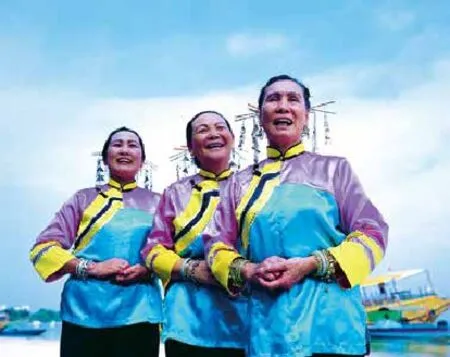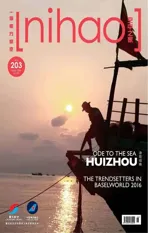渔歌唱晚
2016-06-01
渔歌唱晚
With a mountain range at the back and the South China Sea in front (to the south), Huizhou in southeast Guangdong is a perfect haven to escape city life. Be prepared to be entranced by age-old fi shermen's songs that echo from antiquity, devout prayers that are murmured in Mazu temples, the numerous medicinal herbs that grow in the Luofushan Mountain, and many more.
背靠仙山,面朝大海,惠州让人联想到诗和远方。那些来自远古的歌谣,妈祖庙里虔诚的祈祷,罗浮山上的绿野仙踪,生发出亦真亦幻的意境。

Boat Dwellers' Songs
“Guess what part of a boat is straight, what has two ends, what gives shelter from the wind, and what swims in the water?”
“I guess that the mast of a boat is straight, that the mooring rope has two ends, that the canopy gives shelter from the wind, and that the rudder swims in the water.”
Duets like this one are being sung often in the fi shing villages of Huidong County in the eastern part of Huizhou, especially at sunset when fi shermen come home from a day's fi shing.
66 year old Li Quemei is a villager in one such fi shing village. Due to health problems, she no longer works on the boat, so she devotes most of her time to the care of her restless grandson –sometimes by singing traditional songs. When it came to fi shing songs, Li beamed with delight. “I was already quite good at it when I was only fi ve years old,” she said with a giggle.
As a child, Li spent a lot of time in the boat. She recalled that her parents often traded fi sh for rice, sweet potatoes and other things for the two meals they had every day, and that when caught up in storms or big waves, they had to endure completely soaked clothes. “Back then, they nicknamed us “Dans”, meaning boatmen or boatwomen,” she recalled.
She also remembered that whenever her father caught a large lobster, he would sing a little tune of some sort in a raised voice.
It was not until the 1960s when shelters were built by the local government to house fi shermen that these boat dwellers bid farewell to a drifting life on the open waters. They created a song to express their gratitude to the government. That was when Li was about eight years old.
Today, fi shermen's songs of various themes are still being sung across Huidong County. These themes include the joys and sorrows of life as a fi sherman, and youthful love. Songs are sung on occasions of homecoming, festivals, wedding ceremonies or funerals, or when people offer prayers to Mazu for blessings.

Li Quemei (middle)and her friends singing a fishermen's song.李却妹(中)与姐妹开心地唱着惠东渔歌。

DAN PEOPLE疍民
疍民之歌
“你知什么直溜溜,你知什么弯球球,你知什么赶风走,你知什么海底游?”
“我知大桅直溜溜,我知绳缆两条绳,我知风蓬赶风跑,我知船舵海中游。”
惠东渔村,这样的渔歌对唱在洒满夕阳的海天之际唱响。
66岁的李却妹因身体原因,如今已少到海边走动。更多时候,她哼唱着渔歌哄满地乱跑的小孙子。唱了大半辈子惠东渔歌,李却妹谈起仍眉飞色舞。“5岁还住在船上时,我的渔歌就唱得很棒了。”
李却妹幼时在海上过活,她回忆,当时父母打了鱼虾,便拿到陆上换米、地瓜,一天吃两餐,遇见大风大浪、刮风下雨,衣服湿透没得换。“那时候,陆上的人叫我们疍家婆、疍家仔。”
李却妹还记得,小时候每当打到大龙虾,父亲就会扯起嗓子欢唱:来(啊)唱流(啊)水退干干(哪),一对龙虾藏礁(啊)脚。
直到上世纪60年代,疍民才告别海上漂泊,当地政府为上岸的渔民建起屋舍。渔民们创作了一首名为《党是渔民亲爹娘》的渔歌,感谢党和国家。长到8岁,李却妹开始移居陆地生活,惠东渔歌也正式上岸。
如今,惠东渔歌仍在传唱,惠东渔民用渔歌歌唱生活的酸甜苦辣,既有反映打鱼生活的,也有描述青年男女爱情的,在回港避风、节庆、婚丧等场合大唱渔歌。惠东渔民信奉妈祖,每年祭祀,渔民都要唱渔歌祈福。

Liao Zhizhong, Sixth generation inheritor of Herbal Oil.廖志钟,罗浮山百草油传统制作技艺第六代传人。
A Cure-all Herbal Oil
The Mountain and the Sea have endowed Huizhou with abundant natural resources. Luofushan herbal oil is one such gift given by Nature.
Born and growing up in a village at the foot of the Luofushan Mountain, Mr. Liao Zhizhong was no stranger to the many kinds of medicinal herbs.

Luofushan herbal oil became popular in the mountain region a long time ago and for a time was one of the most widely used herbal oils in southern China and Southeast Asian countries. According to Liao, almost every household had this herbal essence and no one left home to travel without it at the time as it can help relieve headache, dizziness, noxious dampness and mosquito bite symptoms.
According to local people, the herbal medicine dates back more than 1,600 years to the Eastern Jin Dynasty (317-420) when Ge Hong, a noted physician, alchemist and Taoism theorist of the time, discovered it while doing alchemical research. It later became widely accepted in the Lingnan region as an effective treatment for common diseases like epidemic inf l uenza. Even today, traces of the physician's work, including alchemical furnaces and medicine-cleaning pools, can still be found around the mountain.
Luofushan Mountain is home to more than 3,000 species of plants, including 1,200-odd medicinal herbs. The Luofushan herbal oil is produced from 68 herbs and 11 essence oils. The method of extracting herbal essences is similar to that used by Chinese Nobel laureate Tu Youyou in the extraction of artemisinin, which is widely used to treat malaria.
The herbal oil together with its production techniques was included in the list of China's national intangible cultural heritage in 2011. The greatest wish of Mr. Liao, the sixth-generation inheritor of the millennium-old recipe, is to carry it forward and benef i t more people.

Some herbs used to make Luofushan Herbal Oil.制作罗浮山百草油的部分药材。
仙草神油
高山和大海为惠州提供了丰富的物产。罗浮山百草油正是来自大自然的馈赠。
廖志钟是土生土长的惠州人,半个世纪前,他出生在罗浮山下的村落,闻着各种药草的香味长大。
罗浮山百草油很早之前就在罗浮山地区广为流传,时至今日已成为岭南和东南亚地区使用广泛的药用油。廖志钟回忆,在当时,罗浮山百草油早已是居家旅行必备的物品,乡亲们有个头疼脑热,湿毒侵扰,或被蚊虫叮咬,都拿它来涂一涂。
当地人深知,罗浮山百草油的历史可以追溯到1600多年前的东晋时期,由医学家、道教理论家葛洪在罗浮山炼丹时研制而成,后辗转流传于世,对当时岭南瘟病时疫等常见疾患有奇效。如今,在罗浮山,仍可见葛洪当年炼丹的丹炉和洗草药的药池。

罗浮山有3000多种植物,其中中草药就有1200多种。罗浮山百草油用68中草药和11种植物精油精炼而成。与大部分中草药高温煎煮的方式不同,药材经过洗净、切片、晾干、提炼等工序处理完毕后浸泡萃取。此法与获得诺贝尔医学奖的屠呦呦提取青蒿素的原理相似。
2011年,罗浮山百草油传统制作技艺被列入国家级非物质文化遗产名录。与中草药打了半辈子交道的廖志钟也已成为罗浮山百草油的第六代传人,年过半百的他如今最大的愿望就是将这流传千年的药方传承下去,惠泽更多百姓。


Wang Hanchi, an artist of Longmen farmers’paintings.王汉池,龙门农民画画家。


The Joy of an Idyllic Life
Agricultural China in past years highlighted reading and learning as much as farm work. Yet the traditions of rural life in Longmen County in northwestern Huizhou are a bit different: farmers there have kept alive the unique tradition of combining farming with painting.
Longmen farmers' paintings capture festival celebrations or joyful events, unique folk customs, and fi eld labouring scenes as subjects, which are taken from the experience of the daily life in rural communities. Many unique elements of Lingnan and Hakka cultures, such as the folk dance of the local Yao ethnic minority, Hakka folk songs and gift lanterns (as a token of congratulations on the birth of a baby boy), are well captured in the farmers' paintings.
The paintings are characterised by rich colours, naive lines, and creative themes, which together depict the idyllic scene of country life. Each painting tells a unique story, says Wang Hanchi, a wellknown farmer painter from Longmen County.
Early paintings in the 1970s emphasised the use of some basic painting techniques, such as perspective, proportion and structure – what Wang would call “academic painting”. In the years that followed China's reform and opening up in 1978, true breakthroughs began to be made in Longmen farmers' paintings by drawing on traditional folk art like paper-cutting, embroidery and wood-carving.
The creation of a farmer's painting always begins with conception. After that is done, a painter will draw a rough sketch of the images with a pencil. After a few rounds of revisions, the sketch will then be enlarged and put onto a piece of rice paper. After that, the painter will wet the rice paper and add watercolours appropriately to allow them to be fully mixed with the water in a way that is very much like the skills used in traditional Chinese painting.
By taking inspiration from Hakka folk songs, which he loves dearly, Wang has created twelve Hakka folk song-themed paintings, which won him a“Shanhua Award”, China's highest folk art honour. Going forward, he hopes to add more elements of Lingnan, Hakka and Guangfu (or Cantonese) cultures to the art form, which, in turn, will help spread these unique cultures across China and internationally.

Girls to be Married, by Huang Weiping and Chen Shaoyuan.《倩女出阁》,作者黄伟平、陈少元。
田园之乐
中国农耕时代讲究“耕读传家”。而在惠州龙门,农民则是一手锄头,一手画笔,成为惠州一道独特的风景线。
龙门农民画以节庆喜事、特色民俗、田间劳动为主要题材,反映的都是当地农民田间地头的生活,极富岭南文化和客家文化特色,当地瑶族的民俗舞火狗、客家山歌、添丁的贺灯在农民画中都有体现。
浓墨重彩是龙门农民画的一大特色,充满童真的线条和极富想象力的色彩将农村生活描绘得像一首田园诗。用龙门当地知名农民画画家王汉池的话说,每一幅农民画都是一个故事。
创立之初,龙门农民画讲究焦点透视、比例、结构等基本绘画方法,王汉池称之为“学院派”。改革开放后,龙门农民画才真正实现突破,开始吸收继承传统的民间艺术形式,如剪纸、刺绣、木雕等表现方法。
构思好之后,创作者先用铅笔打好底稿,几经修改后,将底稿放大到宣纸上,然后采用国画的创作技巧,用水打湿画纸,然后上色,以便让水与水粉融合。
王汉池爱唱客家山歌,他将客家山歌与龙门农民画结合,创作出12幅客家山歌农民画,并获得“中国民间文艺山花奖”。他希望将来可以借由农民画将岭南文化、客家文化、广府文化融汇贯通并传播开来。
ODE TO THE SEA
Text by Ge Rufeng Photos by Zeng Jian Translation by Leo
